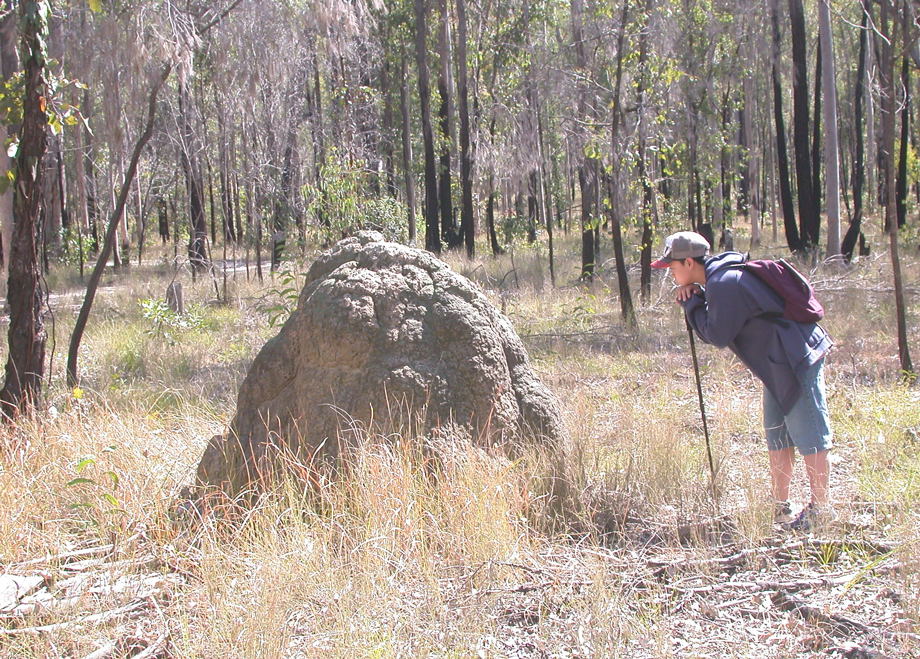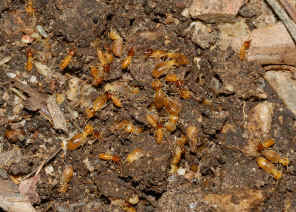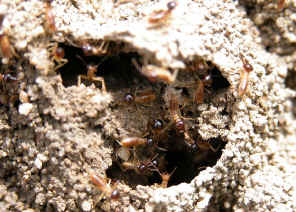|
| |
- This page contains pictures and information about Termites that we found in the Brisbane area, Queensland, Australia.
This page is about termites in nature environments. If you are looking for
information about termites as pest, you may want to search for some other web
sites. Find information on how to identify termites in your office or home.
-
 - Tony is checking a termite mount in Karawatha Forest
-
- Termite is very closely related to Cockroaches.
They are soft-bodied
and live in enclosed environments. All termites are fully social. They live in family group as a colony. Each
colony has several castes, with different body shape and behaviour to perform
different jobs. Usually there are three major castes, the reproductives kings
and queens, soldiers and workers. Nymph stages of all those castes are also
present in the colony.
-


 - Workers, they work inside nest or concealed tunnel. Their body is pale in
colour, sometimes called "White Ants".
-
- Kings
and queens are fully winged and relatively larger in size. Soldiers are
sterile males and females have strong sclerotised head armed with large jaws
or long snout. They can fire sticky secretion when fighting. Their jobs is to
protect the colony. Their defence activities include biting, blocking and
using chemical repellent. Workers are sterile males and females with weaker
body and usually pale in colour. They are the largest number caste in the
colony. Their jobs include gathering food, look after the young, feeding the
soldiers and reproductives, tending the eggs, building and repair the
nest.
-
- Termite
colony is usually in a single nest. The nest is built by the workers. It is
made of finely masticated wood and mud cemented together by sticky salivary
secretion. For some termite species, the nest can be galleries in wood, or
galleries under ground, or for other species it may be a much more complicated
and well designed home mount with numerous stories, rooms, entrances and
ventilation channels.
-

 - Workers and Solders that work outside the nest are darker in colours.
-
- At a
particular time of a year, usually late spring and autumn, a large number of
winged termites fly out from a matured colony and start their own colonies.
Both winged males and winged females will come out irregularly over a period
of a few weeks. Usually all nests will release their winged termites at the
same time. Those termites have the well fed body although they are weak
fliers. They usually fly for a short distance except those carried by wind.
They fly to the places for nesting and they shed their wings. Female release
pheromone to attract the males. Male and female will form tandem pair, look
for suitable site in soil or in wood and start the new colony. They seal
themselves in a small chamber, mate and lay eggs. The new king and queen look
after the first batch of young until they can look after themselves. Then the
first batch of young termites will feed the king and queen. Reproduction
becomes the only job of the king and queen. The new colony starts growing and
becomes a large colony. Only soldiers and workers are produced in a young
colony. Winged termites are only produced in a matured colony which is several
years old.
-
- Usually
there is only one king and one queen, the founder pair, in a colony although
there are many known exceptional cases. A colony may last for over ten years,
depends on species. In many species, there will be the replacement if the
founder king or queen die.
-
- Termites
feed on sound wood, decay wood, dry plant materials, fungi, dung of herbivores
and rich soil. From those food termites utilize the cellulose. In their gut
there are the symbiotic flagellate Protozoa producing chemical and enzymes to digest
those cellulose. Most termites species consume their food on site although
there are some species do carry food back to the nest. Then the workers feed
the soldiers, nymphs and reproductives by mouth-to-mouth transfer of
food.
-
There
are five termite families in Australia.
- Mastotermitidae - Australia Giant Northern
Termites
- There is only one living species in this family, the Mastotermes darwiniensis.
We do not have them here in Brisbane. They are found in tropical north of
Queensland, North Territory and Western Australia.
-
- Kalotermitidae
- Drywood Termites
-
Termites in this family build simple nest in dry or damp dead wood above
ground. The whole colony live
in a serial of galleries and chamber in the wood, i.e., they live surrounded
by their food. Their colonies are small in size. One genus, the Cryptotermes,
in this family poses major economic problems. It is the main group in Drywood
Termites.
-
- Termopsidae
- Dampwood Termites
-
Termites in this family build simple nest in wood, usually with moist. The
whole colony live in a serial of galleries and chamber in the damp wood,
usually rotten and above ground, including the heartwood of living tree. Their
colonies are usually small in size. Those termites cause economic problems
are not in this family.
-
- Rhinotermitidae
- Subterranean Termites
Most species in this family have large colonies and build compact nests.
They build large to very large mounds, up to 2 m high. The genus Coptotermes
in this family includes the termites that do most economic damage.
-
- Termitidae -
Termites
- This is the largest termite family. Most species in this family feed
on weathered wood, dry grass and plant materials in the soil, some in the
nests of other termites. Some species build large to very large colonies.
Species in this family may cause some economic damage but considered minor
when comparing with species in other families.
-
-
- Termite that build Mound Nest

 - Coptotermes sp., family Rhinotermitidae,
mound nest and inside view
- Termite mounts are common in Brisbane's Eucalypt forests. They are usually
built up to about one meter tall. The second photo shows the inside of a
wasted termite mount.
-
-
- Termite with Nasute Soldiers that build mound nest

 - Nasutitermes sp., Family TERMITIDAE, solder, body length 6mm
- Solders checking for intruders at a broken hole of termite
mount.
-
-
- Termite with Nasute Soldiers that build tree nest

 - Nasutitermes walkeri, Family TERMITIDAE, solder, body length 6mm,
body length 6mm
-
-
- Termite that build Arboreal Nest

 - Microcerotermes sp. Family TERMITIDAE, tree nest, diameter
400mm
- Those large mud nests on trees as shown in photos are common in
Brisbane Eucalypt forest. They the the termite nests. They are usually 3-4
meters above ground. These termites have mud tunnels to connect to the
ground near the base of the tree. They also have a networks of tunnels
underground. It is interesting to note that these termites seldom do any
damage to the tree. The termites may have a little chewing around the nest
on bark but for the most part the trees are fine. On the tree trunk there
are only a few mud tunnels.
-
-
- Back to Top
-
- Reference:
- 1. Insects
of Australia - CSIRO, Division of Entomology, Melbourne University
Press, 2nd Edition 1991, p330.
- 2. Insects of Australia and New Zealand - R. J. Tillyard, Angus
& Robertson, Ltd, Sydney, 1926, p100.
- 3. Termites of Northern Australia - By Alan Andersen, Peter Jacklyn, Tracy Dawes-Gromadzki and Ian Morris, Tropical Ecosystems Research Centre,
2006.
- 4. Order
ISOPTERA - Australian Faunal Directory, Australian Biological
Resources Study, 2008.
- 5. Subterranean termites in Queensland
- B.C. Peters, J. King and F.R. Wylie, Queensland Primary Industries and
Fisheries, 2009.
| |
|














